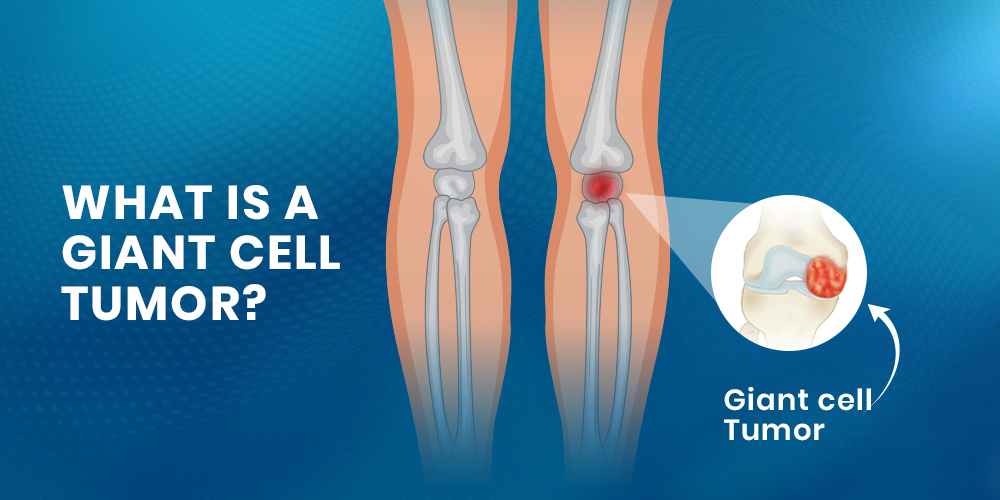
A giant cell tumor is a rare but potentially aggressive bone tumor. Early diagnosis and treatment are key to managing its symptoms and preventing complications. This blog explores everything you need to know about giant cell tumors, from symptoms to the role of clinical trials.
Introduction
Did you know giant cell tumors primarily affect young adults between the ages of 20 and 40? These rare bone tumors, though benign, can cause significant damage if left untreated. Giant cell tumors most commonly appear in the long bones, especially around the knee joint. Early detection is critical to manage the tumor effectively and prevent complications. This blog will explore the symptoms, treatment options, and how clinical trials are advancing care for patients dealing with this condition.
What Is a Giant Cell Tumor?
A giant cell tumor (GCT) is a rare type of bone tumor that typically develops at the ends of long bones. Most cases occur near the knee joint, affecting either the femur or tibia. These tumors are usually benign, meaning they don’t spread to other parts of the body. However, they can be locally aggressive and cause severe damage to the surrounding bone.
Moreover, giant cell tumors often lead to symptoms like pain, swelling, and restricted movement. The tumor is composed of multiple giant cells that appear under a microscope, giving it its name. Although the condition is not classified as cancer, its aggressive behavior can sometimes mimic cancerous growths.
Additionally, GCTs are most common in young adults and rarely appear in children or the elderly. Understanding this tumor’s nature and how it develops is key to recognizing its symptoms early. With proper diagnosis and timely treatment, most people can manage this condition effectively.

What are the common symptoms of giant cell tumors?
Giant cell tumors often begin with mild symptoms that can worsen if left untreated. Pain around the affected area is one of the most common signs. Moreover, swelling near the joint can develop, making movement uncomfortable.
Additionally, people may experience stiffness or limited mobility in the nearby joint. These symptoms can interfere with daily activities, especially when the tumor is near weight-bearing joints like the knee.
Over time, untreated tumors may grow larger and weaken the surrounding bone. This can increase the risk of fractures, which can further complicate the condition. Therefore, early recognition of symptoms is crucial to avoid complications.
If you notice persistent pain, swelling, or trouble moving a joint, consult a healthcare provider immediately. Recognizing these signs early can lead to timely diagnosis and treatment.
Read More: How to Prevent Brain Tumor?
Diagnosing a Giant Cell Tumor
Doctors use several methods to diagnose giant cell tumors accurately. X-rays are usually the first step in identifying the affected area. These images help detect changes in the bone structure caused by the tumor.
Additionally, magnetic resonance imaging (MRI) provides detailed images of the tumor and surrounding tissues. This helps doctors understand the tumor’s size and location.
A biopsy is another important step in confirming the diagnosis. During this procedure, doctors take a small tissue sample to examine under a microscope. This helps rule out other conditions and provides a clear diagnosis.
Early diagnosis plays a vital role in determining the best treatment options. Moreover, it prevents further complications by addressing the tumor before it grows. Once the tumor is identified, doctors can recommend a treatment plan tailored to the patient’s needs.
Is Giant Cell Tumor Dangerous?
Giant Cell Tumors (GCTs) are generally benign, but they can still pose risks due to their locally aggressive behavior. So, Is Giant Cell Tumor Dangerous? In some cases, yes—especially when the tumor grows rapidly, recurs after treatment, or occurs near critical areas like the spine or lungs. Though rare, GCTs can also metastasize, which highlights the importance of timely diagnosis and proper management.
What are the treatment options for giant cell tumors?
Treating giant cell tumors often depends on the tumor’s size and location. Non-surgical options can sometimes manage the condition effectively. Medications like denosumab may help shrink the tumor and reduce its impact on surrounding tissues. Moreover, radiation therapy may be used when surgery is not an option or for tumors in challenging locations.
Surgery is often the preferred method for removing giant cell tumors. Curettage is a common procedure where the tumor is scraped out of the bone. Additionally, doctors may fill the space with bone grafts or cement to support the bone. In some cases, more extensive surgery, such as bone resection, may be required.
However, recurrence remains a concern even after treatment. Regular follow-ups and imaging help monitor for signs of the tumor returning. Moreover, recurring tumors may require additional treatments to manage.
Advanced treatment methods continue to emerge through research, including clinical trials exploring new approaches. These trials aim to improve outcomes for patients while minimizing side effects.
How do clinical trials help in treating giant cell tumors?
Clinical trials play a vital role in finding new ways to treat giant cell tumors. These trials allow patients to access investigational treatments that are not yet widely available. Moreover, they test the safety and effectiveness of new therapies, offering hope for improved outcomes.
NHO-Revive actively advances research through innovative clinical trials. By participating in these studies, patients contribute to the development of cutting-edge treatments. Furthermore, clinical trials often focus on reducing the risk of recurrence or exploring less invasive methods of treatment.
For those interested, Participating in Clinical Trials of Solid Tumor provides detailed information on how to get involved. This link connects patients with ongoing studies tailored to their needs.
Additionally, current research examines treatments targeting specific tumor types and related conditions. This includes exploring therapies for solid tumors and investigating new medications that may benefit patients in the future. Lastly, advancements from clinical trials pave the way for improved care and long-term management options.
Related Tumors and Conditions
Giant cell tumors (GCTs) are unique compared to other bone tumors. Unlike tenosynovial giant cell tumors, which often occur in the joints, GCTs commonly develop in the ends of long bones. Moreover, while both types involve abnormal cell growth, they vary in location and treatment options.
Additionally, Pancoast tumors, which occur in the lungs, differ significantly from GCTs due to their origin and symptoms. Bone metastasis, on the other hand, refers to cancer spreading to bones from another site. This makes it critical to distinguish metastases from primary bone tumors like GCTs.
Cysts and tumors can also be confusing for patients. While cysts are fluid-filled and often non-cancerous, tumors are solid masses that may or may not be cancerous. Hence, proper diagnosis is essential for deciding the right treatment plan.
Understanding these distinctions ensures accurate diagnoses and tailored treatments. Furthermore, knowing the differences helps patients and doctors address specific needs efficiently.
Read More: Phyllodes Tumor of the Breast: Symptoms & Treatment Guide
Prevention and Post-Treatment Care
Preventing complications from giant cell tumors requires maintaining overall bone health. Eating a balanced diet rich in calcium and vitamin D can help. Moreover, regular exercise strengthens bones and reduces risks.
Follow-up care is equally important after treatment. Regular check-ups ensure early detection of any recurrence. Additionally, imaging tests help monitor recovery and identify potential issues early.
Lastly, staying informed about preventive measures and post-treatment care can significantly improve outcomes.
Also Read: Tubular Adenoma of Colon: Causes, Symptoms and Treatment Options
Conclusion
Understanding giant cell tumors is key to managing the condition effectively. Recognizing symptoms, seeking timely diagnosis, and exploring treatment options can make a significant difference.
If you or someone you know is affected by a giant cell tumor, explore innovative treatments and participate in clinical trials through NHO Revive today!
Frequently Asked Questions
Is a giant cell tumor dangerous?
Giant cell tumors (GCTs) are generally benign, but they can be aggressive. They may grow rapidly, cause bone destruction, and lead to fractures. Moreover, in rare cases, they can spread to the lungs. Early diagnosis and treatment help manage risks effectively.
What is a giant cell tumor of bone and soft tissue?
A giant cell tumor of bone is a rare, typically benign tumor that forms at the ends of long bones, like the femur or tibia. However, giant cell tumors can also occur in soft tissues, though this is less common. These tumors consist of large, multinucleated cells and can cause pain, swelling, and limited mobility.
How serious is a giant cell tumor?
A giant cell tumor can be serious, depending on its location and size. It may weaken bones, leading to fractures and mobility issues. Furthermore, untreated tumors can continue to grow, making treatment more challenging. Though rare, some GCTs can metastasize or recur after removal.
What is the difference between osteosarcoma and a giant cell tumor?
Osteosarcoma is a malignant bone cancer that spreads aggressively, while a giant cell tumor is usually benign but locally aggressive. Additionally, osteosarcoma occurs more often in children and teenagers, whereas GCTs typically affect young adults. Proper diagnosis through imaging and biopsy is essential to differentiate between the two.







